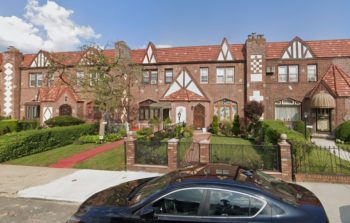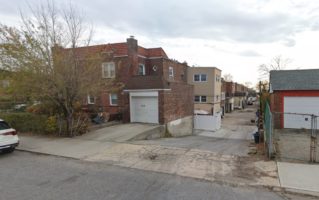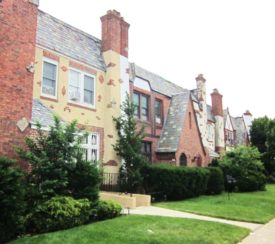
Houses along 222nd Street in the proposed Cambria Heights-222nd Street Historic District. Image Credit: Google Maps.
Both historic districts feature Tudor Revival row houses with whimsical features. On August 10, 2021, the Landmarks Preservation Commission voted to calendar two historic districts in Cambria Heights, Queens for future designation. The Cambria Heights-222nd Street Historic District and the Cambria Heights-227th Street Historic District are both well-preserved examples of the Tudor Revival and Storybook styles and of the 1930s suburban expansion in Queens.
The Cambria Heights – 222nd Street Historic District comprises 46 Tudor Revival row houses from 115-59 222nd Street to 115-104 222nd Street between 115th Road and 116th Avenue. The houses are on both sides of 222nd Street. The houses were all built by Selective Homes, Inc. from 1931-32.
The Cambria Heights – 227th Street Historic District features 50 Tudor Revival row houses along both sides of 227th Street between 116th Avenue and Lindon Boulevard. The historic district features the addresses from 116-01 227th Street to 116-50 227th Street. These houses were developed by Wolosoff Brothers from 1931-32.

The driveways behind houses in the proposed Cambria Heights-222nd Historic District. Image Credit: Google Maps.
Cambria Heights is a neighborhood located at the eastern edge of Queens between Francis Lewis Boulevard and the Nassau County border. The area remained rural into the 1920s as it was far from existing mass transit. As parkway networks began to expand in both Queens and Long Island, Cambria Heights experienced a construction boom in the early 1930s. As a result of the design around cars, both historic districts feature driveways behind the houses to provide access to rear and basement garages, which moves cars to the interior of the block and preserves the continuous front gardens along the street. This was based on a model previously used in Jackson Heights.
Both historic districts feature Tudor Revival style houses that feature “Storybook” style elements. The “Storybook” style originated in California in the 1920s and is reminiscent of medieval and Arts-and-Crafts elements with a fairytale aesthetic. The style adapts Tudor elements by adding bright colors and exaggerated curving forms that feature lots of ornament. The unique style is reminiscent of Hollywood stage sets with fanciful flat facades, pasted on gables and front lawns.

The houses along the proposed Cambria Heights-227th Street Historic District. Image Credit: LPC.
The houses on 222nd Street feature Tudor-arched window openings, terra-cotta roofs, brick facades with stone accents, and chimneys that feature patterned brick and stucco. The houses along 227th Street feature vertically stretched entrance vestibules with flared eaves, half-timbering, jerkinhead roofs, stucco fields with random brick and stone accents, brightly colored slate shingles with ragged edges. Many of the houses in both historic districts still have their large first story wood windows which feature pastel-colored diamond panes.
The first residents of the historic districts were white middle class families. Black families began moving to the area by the 1950s, with some resistance or hostility from some of the white residents and real estate agents. By the 1980s, immigrant families from Caribbean countries like Jamaica, Haiti, Barbados, Trinidad and Tobago, and Guyana moved into Cambria Heights.
Landmarks voted to calendar both historic districts with a vote of 7-0. Public hearings will be hosted at a later date.
By: Veronica Rose (Veronica is the CityLaw fellow and a New York Law School graduate, Class of 2018.)

